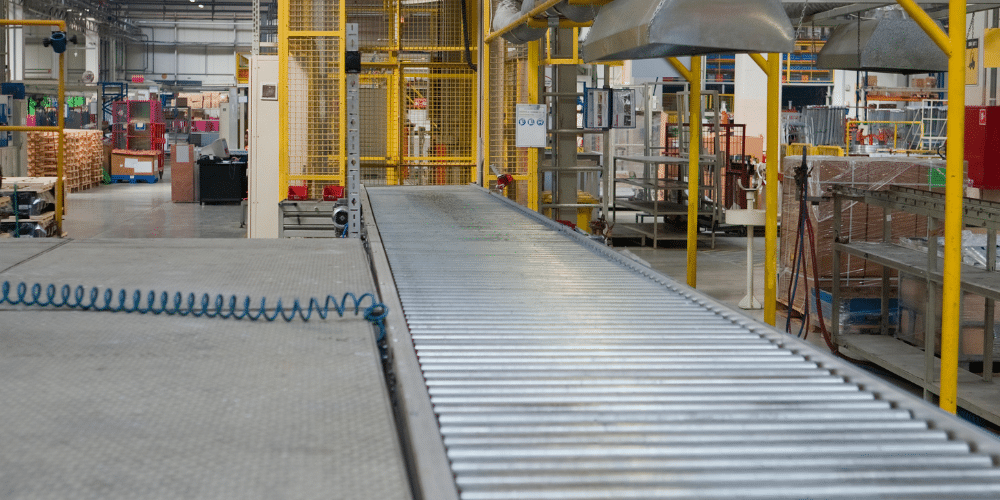
28 Apr Key Considerations When Designing a Modular Conveyor System
Modular conveyor systems have become the backbone of efficient material handling across countless industries — from manufacturing and packaging to food processing and warehousing. Their flexibility, scalability, and customisability make them an ideal choice for businesses looking to improve operational flow without committing to a fixed infrastructure.
However, designing a modular conveyor system isn’t just about plugging components together. To get the most out of your investment, it’s crucial to take a strategic approach during the planning phase. Here are the key considerations when designing a modular conveyor system that truly meets your needs.
-
Space utilisation and layout planning
Space is one of the most valuable assets in any facility. A well-designed conveyor system should optimise available space without disrupting workflow or creating bottlenecks.
Start by mapping out the production floor, taking into account:
- Machine placement
- Operator movement
- Access to maintenance areas
- Emergency exits or walkways
Modular systems are ideal because they can be tailored to tight or irregular layouts. Whether you need straight lines, curves, inclines, or declines, modular conveyors can be configured to fit the space perfectly. Choosing compact, low-profile conveyors can also help make the most of vertical space.
-
Load capacity and product specifications
Every conveyor system must be designed around the type of material or product it’s transporting. Overloading a system can cause inefficiencies, breakdowns, or even safety hazards.
Key questions to address include:
- What is the weight and size of the items being conveyed?
- Are they rigid, delicate, or irregularly shaped?
- Will the materials require special handling, such as temperature or contamination control?
Understanding load capacity isn’t just about weight limits — it also affects motor size, belt type, frame strength, and support structure. For heavier loads, steel-framed systems with reinforced bearings and high-torque drives may be necessary.
-
Integration with existing equipment
In many cases, modular conveyors are introduced to work alongside existing machinery and systems. Seamless integration is essential to maintain efficiency and avoid costly reworks or downtime.
Important integration factors include:
- Conveyor height and transfer points
- Synchronisation with feeders, hoppers, or packaging machines
- Electrical compatibility and control system interfaces
Modular conveyors can be equipped with various drive options, sensor technology, and automation-ready features to support a smooth, fully connected workflow.
-
Modularity and future scalability
One of the main advantages of modular systems is their ability to evolve with your business. Design with tomorrow in mind — not just today’s needs.
Ask yourself:
- Will production volume increase in the next few years?
- Do you foresee adding new product lines?
- Could layout changes be required if the facility expands?
A well-planned modular conveyor system allows for quick additions, rerouting, or component swaps without major downtime. This future-proofs your investment and supports long-term growth.
-
Ease of maintenance and downtime minimisation
Even the best conveyor systems require routine maintenance. When designing your system, consider how easily parts can be accessed, replaced, or cleaned.
Choose modular systems with:
- Tool-less belt removal or quick-release components
- Standardised spare parts
- Clear maintenance zones or inspection points
Reducing downtime is critical to maintaining productivity, so the easier it is to maintain, the better your overall system performance will be.
-
Compliance and safety standards
Conveyor systems must adhere to relevant health, safety, and industry regulations — especially in industries like food, pharmaceuticals, and hazardous materials.
Considerations include:
- Guarding and safety interlocks
- Sanitary designs with easy wash-down capability
- Fire and static safety, especially in dry or dusty environments
Fleming’s modular conveyors are designed with compliance in mind, incorporating safety features and materials that meet Australian and international standards.
Final thoughts: Designing for long-term efficiency
Designing a modular conveyor system is about more than moving products from A to B — it’s about creating a smarter, more efficient operation that grows with your business. By taking the time to evaluate space, load, integration, scalability, and safety, you’ll end up with a system that delivers lasting performance and ROI.
At Fleming Dynamics, we specialise in helping Australian manufacturers and processors design custom modular conveyor systems tailored to their specific needs. From layout planning to installation and aftercare, we’re with you every step of the way.
Need help designing your next conveyor system?
Contact our team today for expert guidance and tailored solutions.
About Fleming Dynamics Australia
Since 1981, Fleming Dynamics has been a trusted provider of industrial water chillers, modular conveyors, and recycling systems for Australian and New Zealand manufacturing industries. Known for expert engineering, reliable service, and sustainable solutions, Fleming Dynamics partners with top brands to deliver innovative, energy-efficient equipment. Our customer-first approach ensures responsive support and tailored solutions across a wide range of applications.


No Comments